“`markdown
How Long Can Dogs Run?
As a dedicated caregiver for your canine companion, understanding their physical capabilities is essential. This knowledge will help you to provide the best care and ensure their health and happiness.
Understanding Your Dog’s Breed
Different breeds have different capabilities. For instance, a Border Collie or a Labrador Retriever may be able to run for long distances without tiring, while a Bulldog or a Dachshund might not be able to sustain the same level of activity.
Table 1: Average Running Distance of Different Breeds
| Breed | Average Running Distance |
|---|---|
| Border Collie | 10-12 miles |
| Labrador Retriever | 8-9 miles |
| Bulldog | 1-2 miles |
| Dachshund | 2-3 miles |
Factors Affecting Running Duration
Factors such as age, health conditions, and the weather can significantly impact how long your dog can comfortably run.
- Age: Puppies and older dogs will not be able to run for as long as healthy adult dogs.
- Health Conditions: Dogs with health issues like arthritis, heart disease, or obesity may not be able to run as far.
- Weather: Hot or cold weather can affect your dog’s ability to run long distances.
The Importance of Regular Exercise
Regular exercise is crucial for your dog’s overall health. It helps maintain a healthy weight, keeps their heart healthy, and can even improve their mood.
- Weight Management: Regular exercise helps burn calories and keep your dog at a healthy weight.
- Heart Health: Like humans, cardiovascular exercise is beneficial for dogs too.
- Mental Health: Regular exercise can help reduce anxiety and improve your dog’s mood.
Signs Your Dog Has Run Enough
Your dog can’t tell you when they’ve had enough, but there are signs you can look for:
- Excessive panting or difficulty breathing
- Slowing down or refusing to move
- Limping or showing signs of pain
Frequently Asked Questions
Q: Can I take my dog for a run every day?
A: Yes, most dogs will benefit from daily exercise. However, the distance and intensity should be adjusted according to their age, breed, and health.
Q: Is it bad for dogs to run on pavement?
A: It can be. Hard surfaces can be tough on your dog’s joints and paws. Try to find softer surfaces like grass or dirt trails for your runs.
Q: How can I tell if my dog is enjoying their run?
A: If your dog is wagging their tail, keeping up with you, and not showing signs of distress, they are likely enjoying the run.
Remember, as a caregiver, it’s your responsibility to ensure your dog’s physical activities are safe and enjoyable. Happy running!
“`



